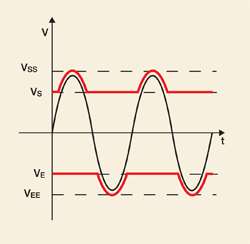Headphone amp design: Quality vs. efficiency
A quick study of Class H vs. Class D shows several tradeoffs
BY ROB KRATAS
Cirrus Logic, Austin, TX
http://www.cirrus.com
In recent years, Class D amplifiers have made inroads into audio consumer electronics, automotive, and portable audio world with the allure of a smaller implementation area and higher efficiency. This efficiency has helped scale automotive amplifiers and portable media docking stations to have more power in a smaller form factor, driving a whole new set of consumer audio devices.
However, there is a specter that follows this new technology. As in all engineering discussions, there is a tradeoff for this increased efficiency and smaller form factor. Increased distortion (a.k.a. noise) and electromagnetic interference (EMI) are the hurdles that must be overcome in the pursuit of the 90% to 95% efficiency that Class D amplifiers can offer.
Class AB
Traditional Class AB amplifiers, a class of nonswitching amplifiers, have been refined over the years to produce the audio performance that audiophiles expect. When compared with a Class D amplifier and its inherent dead-band time, the linearity of nonswitching amplifiers is superior. Dead-band time is defined as the “off” time that a switching amplifier is not supplying voltage to the load or speaker in order to prevent shorting the power supply through the output devices. This time off is at the root of why these amplifiers are considered nonlinear.
The dead-band time of a nonswitching amplifier is more easily minimized than that of a switching amplifier and, therefore, has considerably better audio performance. Additionally, the overall noise floor of a switching amplifier is adversely affected by the nonfiltered content in the output signals. The downside of the Class AB amplifier is that it has a maximum theoretical efficiency of around 78%. This efficiency is somewhat misleading because the highest efficiency of a nonswitching amplifier is only realized at the maximum output of the amplifier before clipping. So a Class AB amplifier hits a maximum efficiency right before the amplifier clips, which is an unrealistic region for an amplifier to constantly operate. For average use, most Class AB amplifiers operate in the 20% to 30% region.

Fig. 1. Graphical representation of Class H power rail adjustment.
So if engineering is all about trade-offs, then there must be a middle ground. An amplifier should be able to maximize the operating efficiency of the system while not compromising its performance.
One way to do this is to modulate the power supply rails of the Class AB amplifier to follow the contour of the audio output. In this fashion, the Class AB amplifier that was operating at 20% to 30% efficiency can now approach realistic operating efficiencies of around 45% to 55%. This product is known as a Class H amplifier.
Class H
This Class H architecture provides less efficiency than Class D, but offers a significant upside in performance for the system designer. The amplifier is effectively a Class AB design, so dead-band time is insignificant, and therefore its distortion level is significantly less than a Class D amplifier. This fact is important to note when considering its end application.
Class AB amplifiers have dominated the headphone amplifier market because they offer the best performance. This is noteworthy because a Class D headphone amplifier, especially the filterless topology frequently used in consumer electronics, can create an audible noise floor that the end user could easily hear.
By adding a Class H controller, a system designer can increase efficiency, while maintaining the same quality audio (lower noise floor and better linearity) that is expected by today’s consumer. Another advantage of nonswitching amplifiers for headphone applications is that they reduce EMI over Class D.
The headphone wires will act as antenna’s that can send high frequency switching noise out into the system environment. System designers will have to attenuate this noise with external filters and/or shields that increase board space and BOM cost. Nonswitching amplifiers, such as Class H, virtually eliminate this EMI concern and have an overall cheaper BOM cost.
In all cases, it comes down to trade-offs. If a system designer has to drive a significant power output and is concerned mostly with maximizing power output, and performance is secondary, then they should consider a Class D amplifier. If, on the other hand, they are concerned primarily about audio performance, and efficiency is a close second, they should strongly consider the advantages of a Class H design. ■
For more on headphone amps, visit http://www2.electronicproducts.com/AnalogMixICs.aspx.
Advertisement
Learn more about Cirrus Logic





